Who doesn’t love a sweet, juicy watermelon? Native to Africa, this type of melon needs warm weather and a good amount of time to grow. With proper care, you’ll have ripe melons ready to eat by the end of the summer. Read on to learn the steps for growing and harvesting watermelons in your garden.
About Watermelon
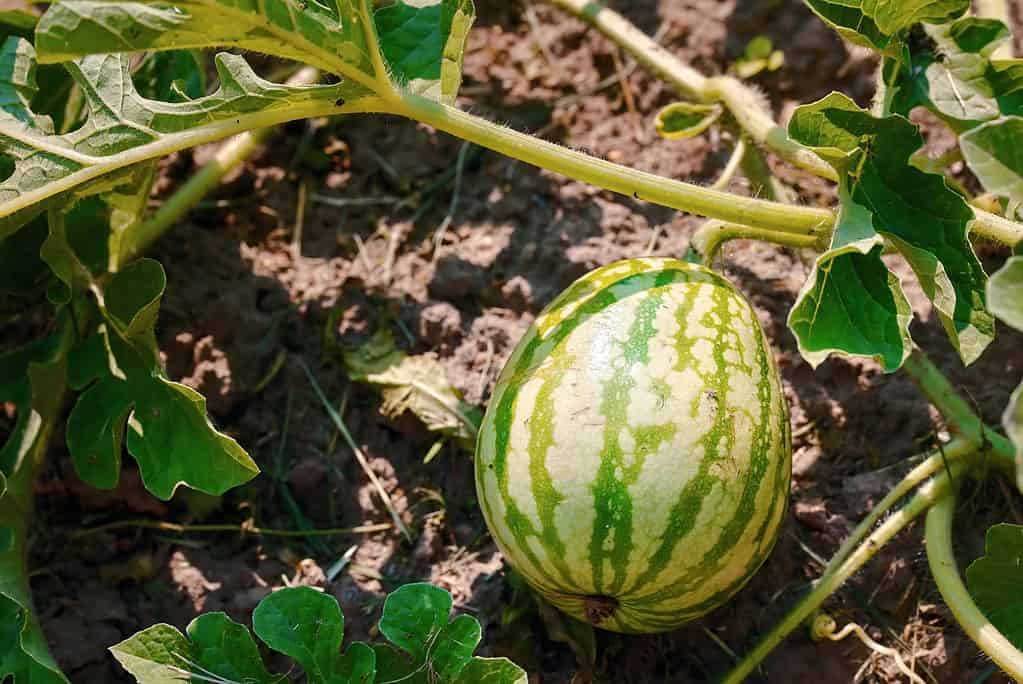
Start seeds indoors to give your crop the best chance of success in cooler climates.
©Tricky_Shark/Shutterstock.com
When planting watermelons, selecting the right variety is important for successful cultivation. Varieties such as Sugar Baby and Crimson Sweet are well suited to cooler climates and take fewer days to mature than other varieties. Generally, it will take between 70 and 100 days from planting until harvest time.
Start seeds indoors to give your crop the best chance of success in cooler climates. You can also purchase seedlings from a nursery at least two weeks before the last frost date in your area. Planting outdoors once all danger of frost has passed will ensure that your plants have enough warm weather during their growing period so they can reach maturity.
Where to Plant
Adding aged manure, compost, or seaweed to your soil before planting watermelon is essential for achieving the best results. Watermelons are considered heavy feeders because they require a lot of nutrients in order to thrive. Loamy soil with a slightly sandy texture that drains well is ideal for growing watermelons as it allows adequate drainage while still providing enough moisture retention. Poor draining clay soils can be problematic, as they tend to retain too much moisture, which can lead to root rot or other problems.
To ensure your watermelons receive the best possible growing conditions, choose an area with a soil pH between 6.0 and 7.5. Keep in mind that watermelons require a great deal of space for their vines to sprawl – up to 20 square feet per plant! For larger varieties, you may need even more room. It’s essential that you plant them in an area where they won’t compete with other crops for space or resources such as sunlight and nutrients from the soil.
When to Plant
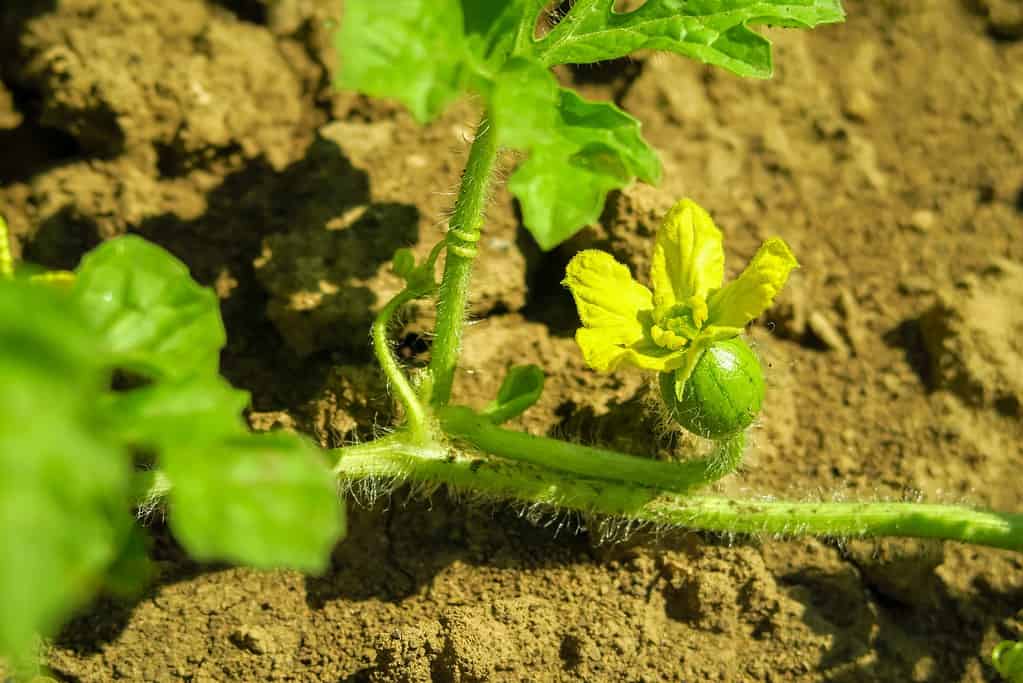
Watermelon
plants need a minimum of six hours of direct sunlight
per day and thrive in the heat.
©1777177/Shutterstock.com
When starting your watermelon seeds indoors in cooler climates, be sure to select a suitable container and potting soil mix. Plant the seeds 1/2 inch deep and keep them moist until they germinate, which usually takes between 7-10 days. When transplanting the seedlings into the garden, make sure to harden them off first by gradually introducing them to outdoor conditions over a period of several days. Take them outside when the soil temperature has reached 65°F.
In warmer climates with longer growing seasons, direct sowing is an option once all danger of frost has passed and when soils have properly warmed up to at least 65°F. Make sure you choose a sunny location with well-drained soil that is free from weeds or debris. Watermelon plants need a minimum of six hours of direct sunlight per day and thrive in the heat.
If you don’t want to start your own seeds, you can purchase young watermelon plants from a nursery. Make sure that the chance of frost occurring is no longer present. These plants are very tender and could be damaged by cold temperatures. To help warm the soil and ensure your plants get off to a strong start, consider laying black plastic over your planting area prior to putting in the young watermelons. This should give them an extra warmth boost during the initial growing period.
A benefit of starting with young watermelon plants rather than seeds is that it can result in an earlier harvest (usually up to 2 weeks). If you live in a cooler climate, this might be something worth considering.
How to Plant
When planting watermelons, consider the spacing of your plants. For raised hills, you should space each plant 2-3 feet apart in a 5-foot-wide hill. Using hills allows for good drainage and will keep the sun’s heat longer, which can help promote growth.
If you are growing watermelons in traditional rows, make sure to give them at least 6 feet of space between each other. Additionally, find an area with lots of direct sunlight since this type of fruit requires plenty of warmth and light for optimal growth.
When sowing seeds outdoors, 1/2 to 1 inch of soil should be placed over the seed. If you’re planting indoors in a seed-starting pot, only 1/4 to 1/2 inch of soil is necessary. To allow for more root growth, pick larger pots than usual – compostable ones are an ideal choice as they can be cut away or planted directly into the garden, reducing the risk of damaging delicate young roots during transplanting.
When direct seeding outdoors, sow 4 to 6 seeds per hill and thin down later on to 2 or 3 plants once they have sprouted and grown a few inches tall.
How to Grow
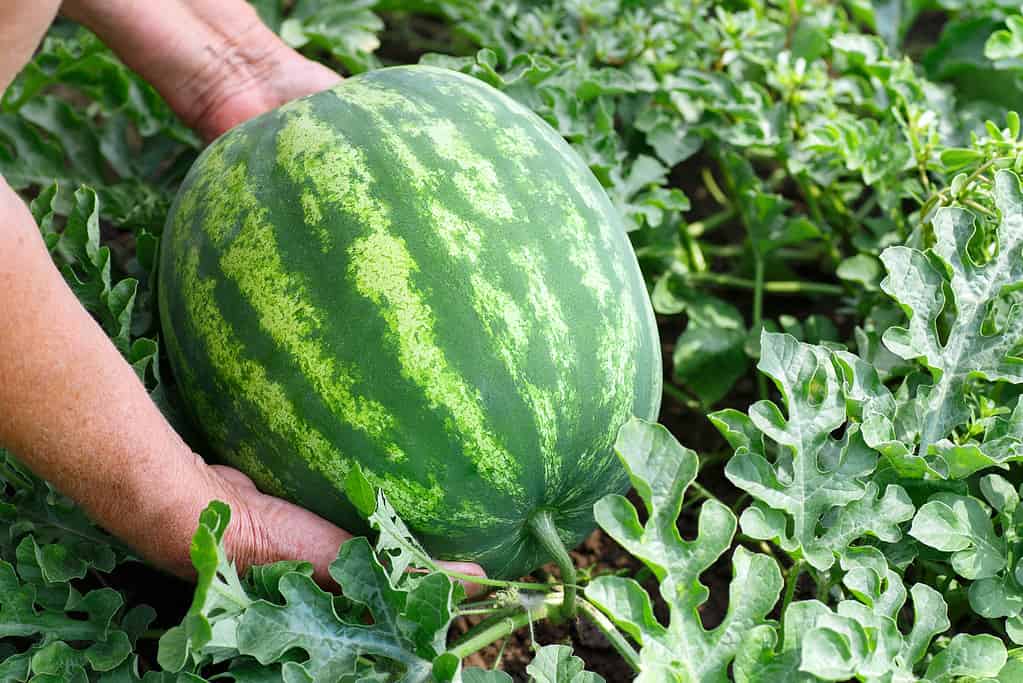
Male flowers (which do not have a swollen base) will typically appear several weeks before female flowers and usually fall off shortly after appearing.
©Alter-ego/Shutterstock.com
It’s important to water your melon plants consistently throughout the growing process. Watering one or two inches per week is sufficient. However, make sure the soil stays moist but not waterlogged. Aim to water your plants in the morning at their base and avoid getting any of the leaves wet, as this can cause diseases. Once flowers begin to form and fruit grows, it is best to reduce watering only slightly, as dry weather produces sweeter melons.
Fertilizing is optional, but if you choose to do so, pick one with a higher nitrogen content than phosphorus and potassium, which will encourage leaf and vine growth early on in the season. Once flowering begins, switch over to fertilizer with less nitrogen to get more flowers and fruits instead of just foliage growth. A seaweed-based fertilizer works well for this purpose.
It is important to recognize the difference between male and female flowers when growing watermelon. Male flowers (which do not have a swollen base) will typically appear several weeks before female flowers and usually fall off shortly after appearing. Female flowers (which have a bulb at their base) will remain on the vine and are necessary for pollination, which is required for fruit production. To ensure the successful pollination of your watermelons, be sure to provide appropriate bee-friendly habitats in or around your garden. Good sources of pollen are needed throughout the season for bees to thrive – this can include planting wildflowers or other flowering plants near your watermelon patch that bloom during different times of the year. Providing these resources helps guarantee that you’ll get plenty of healthy melons come harvest time!
To prevent rotting, carefully pick up the ripening fruit and place a sheet of cardboard or a sprinkling of straw between it and the ground. Placing black plastic or straw around the plants will warm the soil, keep weeds down, and lift the forming melons off the dirt.
Pruning isn’t usually needed for watermelon plants, but it can help with productivity if you don’t let lateral vines grow. When the plant is young, snip off the end buds as they form (before they turn into side shoots). You can also remove some blossoms to focus the energy on fewer but larger fruits.
When to Harvest
Harvesting watermelons is an important technique to ensure that you get the best flavor and sweetness out of them. Watermelon does not continue to ripen after it has been picked, so timing your harvest correctly is essential.
On average, a watermelon will take two weeks to reach its peak ripeness. Keep an eye on them throughout this two-week period to determine the best picking day. Your seed packet should give you a clue as to the best time to harvest.
How to Tell If a Watermelon Is Ripe
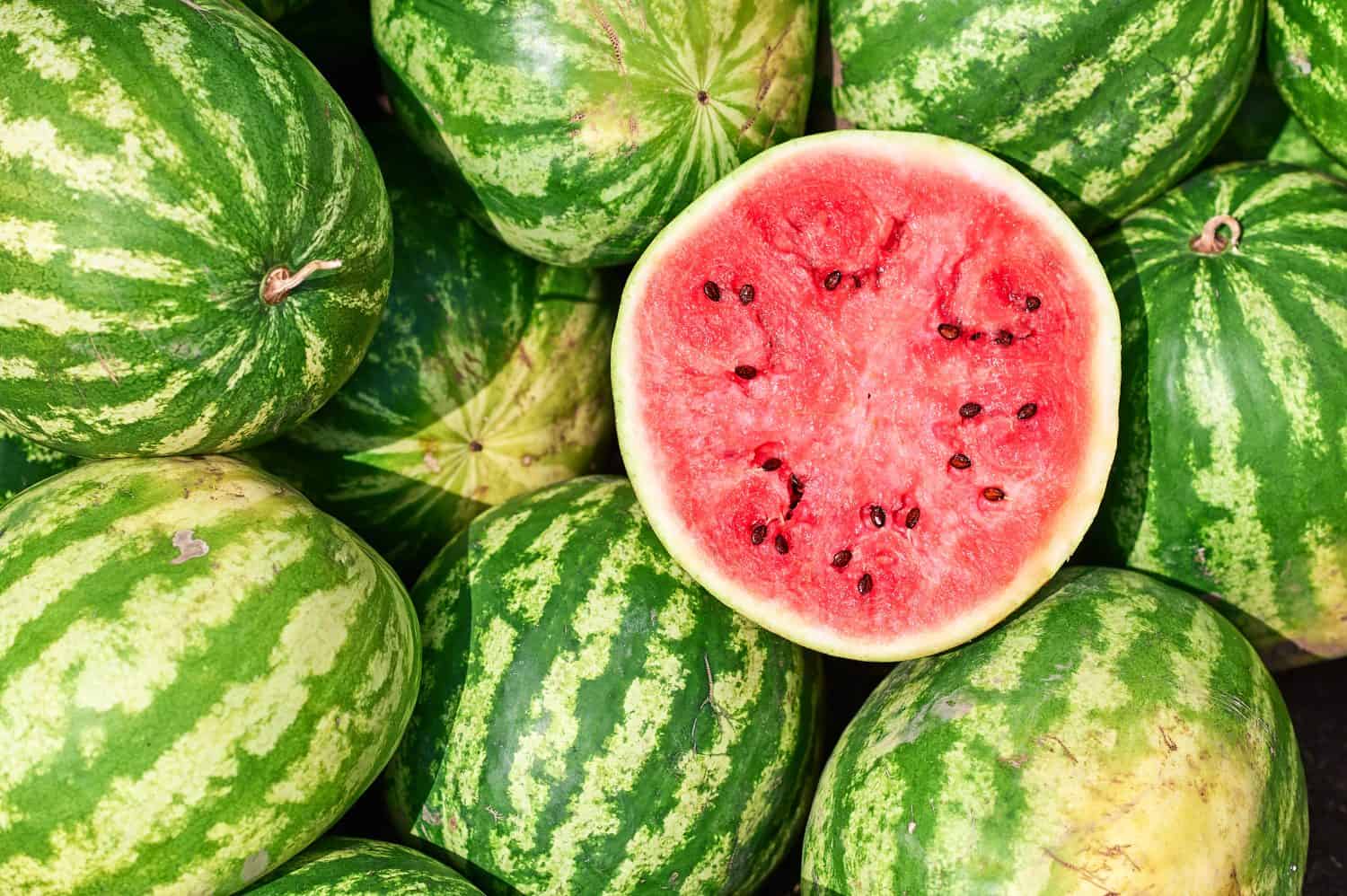
The bottom of a ripe watermelon should be a creamy yellow.
Image: Denis_Zai, Shutterstock
©Denis_Zai/Shutterstock.com
To determine if a watermelon is ripe, thump it and listen for a hollow sound. Look at the color on the top and the bottom of the fruit. A ripe watermelon will have a cream or yellow bottom, and the stripes will have little contrast. Gently press it. If it gives slightly, it is ready to be picked. Lastly, check the tendril. The melon is nearly ripe or ripe if it’s half-dead. If the tendril is fully dead, the watermelon is ripe or overripe. If all of these criteria are met, it is time to pick and eat your fresh watermelon!
How to Harvest
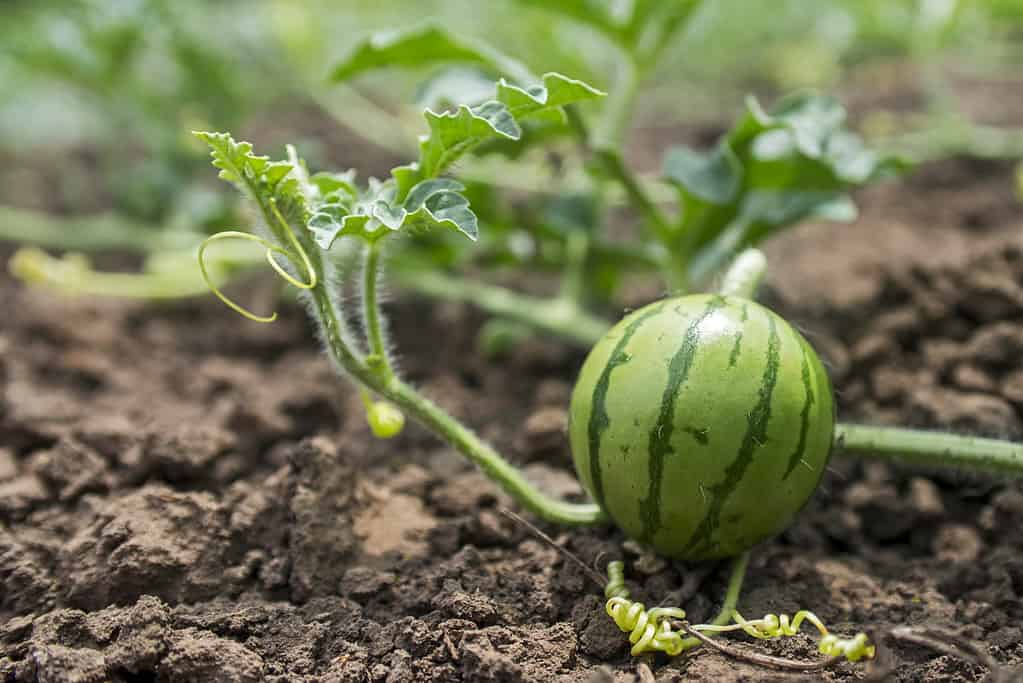
Watermelons can be stored uncut at room temperature for up to 10 days.
©Andrii Spy_k/Shutterstock.com
Once the watermelon has reached its full size, it is ready to be harvested. To do this, ensure you have a sharp knife and cut the stem close to the fruit. It’s important not to pull at the vine as this can cause irreparable damage, which will affect any other watermelons growing from that same vine – they may never ripen properly! Make sure your knife is sharp enough so that you don’t need too much force when cutting – if in doubt, sharpen it before harvesting your watermelons.
How to Store
Watermelons can be stored uncut at room temperature for up to 10 days. If you have cut into the watermelon, it should be tightly wrapped in plastic and kept in the refrigerator, where it will stay fresh for up to 4 days.
Companion Plants
Lavender, borage, rosemary, marigolds, mint, tansy, basil, catnip, radishes, onions, garlic, and chives are all excellent companion plants for watermelons.
Flowers: Planting lavender, borage, rosemary, or marigolds near your watermelon plants will not only attract beneficial insects like bees that are necessary for successful pollination, but it can also help to repel aphids. Aphids feed on the leaves and tendrils of the watermelon plant, which can cause significant damage if not prevented. Additionally, these companion plants have bright colors and sweet scents, making them a great addition to any garden.
Great Companion Plants
Herbs: Strong-smelling, aromatic herbs like basil, catnip, mint, and tansy are excellent companion plants for watermelon. They also help to repel insects. Planting these herbs in pots or beds near the melon patch will provide further protection against pests. Do not plant them directly within the melon patch itself. Instead, keep them in pots surrounding the area so that their strong scents can deter any unwelcome visitors.
Radishes: Radishes are an ideal choice for companion plants with watermelon. They sprout quickly and will have already been harvested when it’s time to harvest your watermelons. This means you can maximize garden space without worrying about overcrowding or competition for resources. In addition to their fast growth rate, radishes also help control weeds around your melons since they produce shallow roots. These roots don’t interfere with each other’s access to nutrients.
Alliums: When you grow watermelons, it’s beneficial to plant alliums such as chives, leeks, onions, and garlic nearby. Alliums are great companion plants for a number of reasons. They help repel pests like aphids and mites, aid in pollination by attracting bees and other helpful insects, improve soil health, and act as an anti-fungal agent against diseases that can attack your watermelon crop. As an added bonus, growing alliums will provide you with tasty ingredients for your favorite recipes!
Summary of How to Grow a Watermelon
| Growing Watermelon | Watermelon Recommendations |
|---|---|
| Sun | Full sun, six or more hours of direct sunlight per day |
| Soil | Loamy and slightly sandy. pH 6.0 to 7.5 |
| When to Plant | Indoors – three weeks before the last frost date Direct seed – When soil is 65°F Seedlings – After all the danger of frost is past |
| Planting Measurements | Hills – 3 seeds per 5-foot mound Rows – rows six feet apart Seeds – plant seeds one inch deep |
| When to Harvest | 70-100 days. When it passes the thump test and is a creamy yellow on the bottom. Stripes should have little contrast. |
| How to Store | Uncut – room temperature for ten days Cut – Wrapped in plastic in the refrigerator for four days. |
| Companion Plants | Lavender, borage, rosemary, marigolds, mint, tansy, basil, catnip, radishes, onions, garlic, leeks, and chives. |
The photo featured at the top of this post is © Alter-ego/Shutterstock.com
Thank you for reading! Have some feedback for us? Contact the AZ Animals editorial team.






